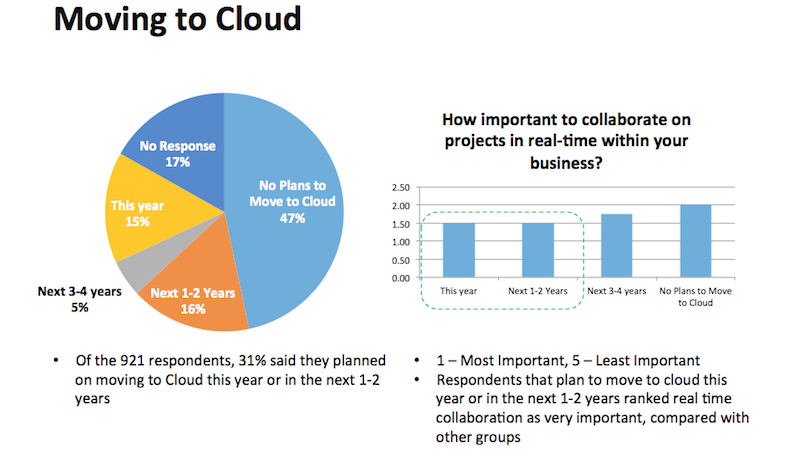The majority of construction companies currently aren't using cloud software, and fewer than two-fifths plan to move their takeoff, estimating, or project management functions onto the cloud within the next four years, according to a survey of estimators, executives, and project managers conducted by Houston-based On Center Software, which provides technology solutions to construction professionals.
Among the survey’s 921 respondents, 42% were estimators, 22% managers or chief estimators, 22% project managers, and 13% executives.
Being able to communicate using a single source of data is the most important factor to all respondents when they are evaluating different software providers. More than 60% of each respondent group indicates that being able to integrate their systems—particularly estimating, takeoffs, and project management—is a requirement when evaluating providers.
The respondents are also looking for solutions that minimize costly errors and rework.

Yet, about 70% of those polled say their companies aren’t using cloud software today. However, 15% plan to move their processes to the cloud this year, 16% within the next two years, and 5% within the next four years.
Nearly half of the respondents—47%—aren’t planning to move their processes to the cloud within this time period.
Angelo Castelli, On Center Software’s Chief Operating Officer, points out the irony of this resistance, in that a significant portion of the industry “doesn’t realize” yet that the kind of broad collaboration companies are seeking, which would allow them to communicate about projects in real time using a single data source, can only be provided by the cloud.
The survey’s findings, though, do seem to reflect the construction’s industry’s basic conservatism when it comes to technology. Laptops still dominate as the preferred mobile device among the respondent groups. Less than half of the respondents are currently using smartphones. Android is the most widely used smartphone among respondents whose companies plan to move to the cloud within the next two years.
Related Stories
| Aug 11, 2010
BIM adoption tops 80% among the nation's largest AEC firms, according to BD+C's Giants 300 survey
The nation's largest architecture, engineering, and construction companies are on the BIM bandwagon in a big way, according to Building Design+Construction's premier Top 50 BIM Adopters ranking, published as part of the 2009 Giants 300 survey. Of the 320 AEC firms that participated in Giants survey, 83% report having at least one BIM seat license in house, half have more than 30 seats, and near...
| Aug 11, 2010
Thrown For a Loop in China
While the Bird's Nest and Water Cube captured all the TV coverage during the Beijing Olympics in August, the Rem Koolhaas-designed CCTV Headquarters in Beijing—known as the “Drunken Towers” or “Big Shorts,” for its unusual shape—is certain to steal the show when it opens next year.
| Aug 11, 2010
Great Solutions: BIM/Information Technology
4. Architectural Visualization through Gaming Technology Before 3D walkthroughs for client presentations were popular, HKS manager of Advanced Technologies Pat Carmichael and his team were working to marry gaming engines with 3D building models. "What's being tasked to us more and more is not just to show design, but to show function," Carmichael said.
| Aug 11, 2010
Great Solutions: Collaboration
9. HOK Takes Videoconferencing to A New Level with its Advanced Collaboration Rooms To help foster collaboration among its 2,212 employees while cutting travel time, expenses, and carbon emissions traveling between its 24 office locations, HOK is fitting out its major offices with prototype videoconferencing rooms that are like no other in the U.
| Aug 11, 2010
BIM school, green school: California's newest high-performance school
Nestled deep in the Napa Valley, the city of American Canyon is one of a number of new communities in Northern California that have experienced tremendous growth in the last five years. Located 42 miles northeast of San Francisco, American Canyon had a population of just over 9,000 in 2000; by 2008, that figure stood at 15,276, with 28% of the population under age 18.







